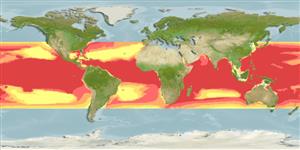Common names from other countries
Environment: milieu / climate zone / depth range / distribution range
Ecologia
marino batipelagico; distribuzione batimetrica 58 - 1000 m (Ref. 13628). Tropical; 40°N - 40°S
Atlantic, Indian and Pacific: circumtropical.
Size / Peso / Age
Maturity: Lm ? range ? - ? cm
Max length : 20.0 cm TL maschio/sesso non determinato; (Ref. 4412); Età massima riportata: 4 anni (Ref. 31631)
Spine dorsali (totale) : 11 - 12; Raggi dorsali molli (totale) : 15 - 17; Spine anali: 2; Raggi anali molli: 14 - 16; Vertebre: 30 - 31. Light tan to brown in color; caudal fin dusky, other fins clear (Ref. 4412). Teeth patches on midline of roof of mouth and tongue large, broad and granular (sometimes partly obscured by mucous) (Ref 9834).
Occurs from the border of the continental shelf to about 1,000 m depth (Ref. 13628). Found near the surface at night (Ref. 9834). Adults feed mainly on salps (Ref. 33689).
Life cycle and mating behavior
Maturities | Riproduzione | Spawnings | Egg(s) | Fecundities | Larve
Haedrich, R.L., 1986. Nomeidae. p. 846-850. In M.M. Smith and P.C. Heemstra (eds.) Smiths' sea fishes. Springer-Verlag, Berlin. (Ref. 4412)
IUCN Red List Status (Ref. 130435)
CITES (Ref. 128078)
Not Evaluated
Threat to humans
Harmless
Human uses
Pesca: di nessun interesse
Strumenti
Special reports
Download XML
Fonti Internet
Estimates based on models
Preferred temperature (Ref.
115969): 8.7 - 19, mean 12.7 (based on 823 cells).
Phylogenetic diversity index (Ref.
82804): PD
50 = 0.5010 [Uniqueness, from 0.5 = low to 2.0 = high].
Bayesian length-weight: a=0.00871 (0.00387 - 0.01962), b=3.07 (2.86 - 3.28), in cm Total Length, based on LWR estimates for this species & (Sub)family-body (Ref.
93245).
Trophic level (Ref.
69278): 3.6 ±0.2 se; based on diet studies.
Resilienza (Ref.
120179): Medio, tempo minimo di raddoppiamento della popolazione 1.4 - 4.4 anni (Assuming tmax>4).
Fishing Vulnerability (Ref.
59153): Low vulnerability (11 of 100).
